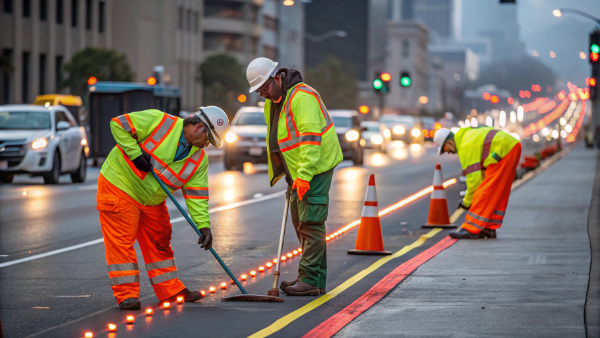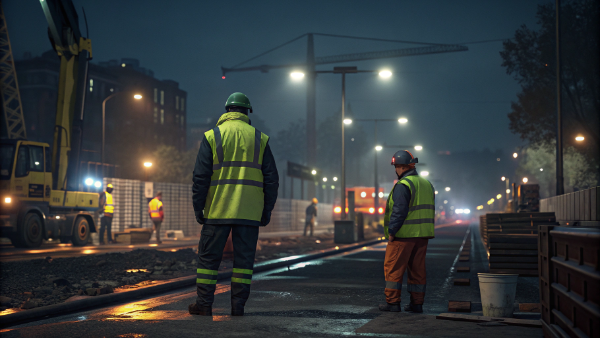Workers face danger on roadways every day. Choosing the wrong vest increases risk. Understanding safety standards like "Type R" is critical for protection.
"Type R" stands for "Roadway." It means the safety vest is designed and certified under the ANSI/ISEA 107 standard for workers exposed to traffic. It offers visibility against complex backgrounds where vehicle speeds exceed 25 mph.
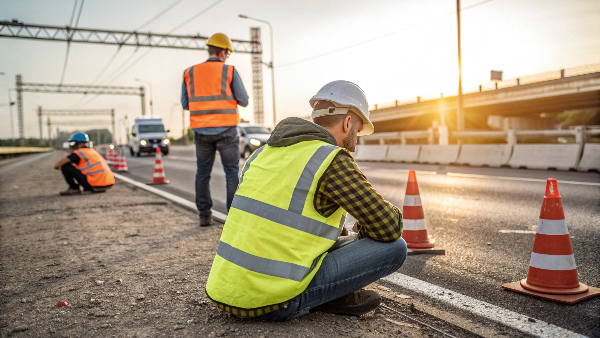
This simple letter holds a lot of meaning for worker safety. But it's just one piece of the puzzle. To really keep your team safe, you need to understand how "Type" works with "Class" and other factors. Let's break it down further, so you can make the best choice for your crew.
What are the different types and levels of safety vests?
Selecting a vest feels complicated with all the labels. The wrong choice could fail an inspection. We can make sense of the Types and Classes for you.
Safety vests are categorized by the ANSI/ISEA 107 standard1 into Performance Class2es (1, 2, 3) for visibility levels and Types (O, R, P) for the work environment. Class 33 offers the most visibility, while Type R is for roadway work.
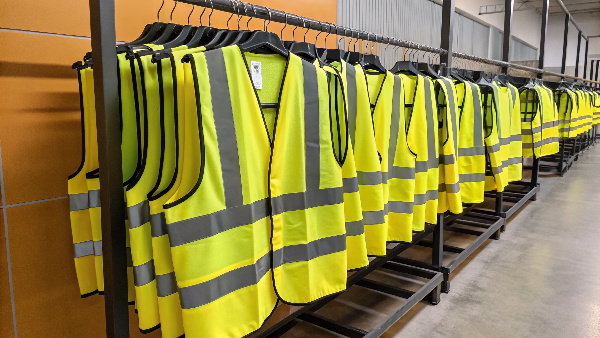
As a manufacturer, we live by the ANSI/ISEA 107 standard. It is the rulebook that guarantees a vest will perform as expected. This standard breaks down vests into two main categories: Performance Class and Garment Type4.
Performance Class (Levels of Visibility)
Performance Class tells you how visible the vest is. It is based on the total amount of fluorescent background material and reflective tape on the garment.
- Class 1: For low-risk environments, like warehouse workers or parking attendants, where traffic is slow (under 25 mph) and separated from them.
- Class 2: For roadway workers exposed to traffic moving from 25-50 mph. This is a very common level for many construction and utility jobs.
- Class 3: The highest level of visibility. It is for workers in the most dangerous, high-speed environments (over 50 mph) or in bad weather conditions.
Garment Type (Work Environment)
Garment Type tells you where the vest is supposed to be used.
- Type O: For "Off-Road" (Occupational) use. This corresponds with Class 1.
- Type R: For "Roadway" use. This is needed for Class 2 and Class 3 vests.
- Type P: For "Public Safety" professionals.
I often advise my long-term client, Danny Cheng in California, on this. His customers need vests for warehouse staff (Type O, Class 1) and a different line for highway crews (Type R, Class 3). Choosing the right combination is critical.
| Category | Level 1 | Level 2 | Level 3 |
|---|---|---|---|
| Performance Class | Class 1 | Class 2 | Class 3 |
| Garment Type | Type O | Type R / P | Type R / P |
| Typical User | Warehouse Worker | Road Construction | Highway Flagger |
What is the difference between Type P and Type R safety vests?
Your roadway crew and an emergency responder have different needs. Giving them the same vest can be a mistake. Let's clarify the key differences between Type P and R.
Type R (Roadway) vests5 are for workers needing visibility from traffic, like road crews. Type P (Public Safety) vests6 are for emergency responders. They offer high visibility but also allow easy access to equipment on their belts, which is a key design difference.
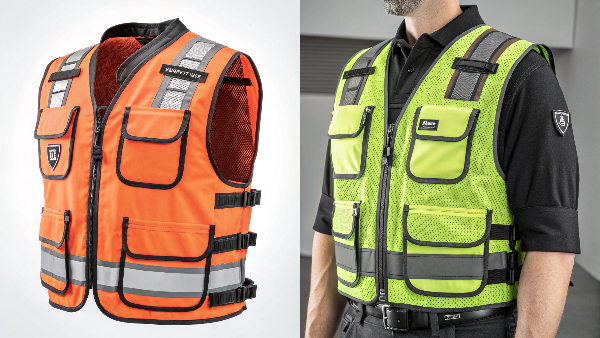
The main difference between Type R and Type P is the design philosophy, even though both offer Class 2 or 3 visibility. It all comes down to the user's primary job function.
A Type R vest is designed with one main goal: make the worker as visible as possible to passing traffic. The person wearing it, like a highway painter or construction flagger, is focused on their job, not on the cars. So, the vest needs to provide maximum coverage without interfering with their work.
A Type P vest is for public safety workers like police officers, firefighters, and paramedics. They also need to be seen by traffic, but they have another critical need: immediate access to their tools. This includes radios, firearms, medical equipment, and other gear on their duty belts. Because of this, Type P vests are often designed to be shorter or have cutaways on the sides. They might also have special features like breakaway zippers or shoulders to prevent them from getting snagged when confronting a suspect or accessing a vehicle. We developed a custom Type P vest for one of Danny's clients that had specific radio loops and a shorter front to keep the duty belt clear. This kind of thoughtful, user-focused design7 is what we excel at.
| Feature | Type R (Roadway) | Type P (Public Safety) |
|---|---|---|
| Primary User | Construction, Utility Workers | Police, Fire, EMS |
| Main Goal | Maximum visibility to traffic | Visibility + Access to equipment |
| Design Feature | Full coverage for visibility | Often shorter or with cutouts |
| Example Scenario | Paving a highway | Responding to a roadside accident |
What does Class 3 Type R mean?
Some jobs have zero room for error with visibility. Workers in the most dangerous conditions need the highest protection. That is where Class 3 Type R comes in.
Class 3 Type R is the highest level of visibility protection for workers in high-speed traffic environments. It combines the "Roadway" designation (Type R) with the maximum amount of background and reflective material, including sleeves, required by Class 3.
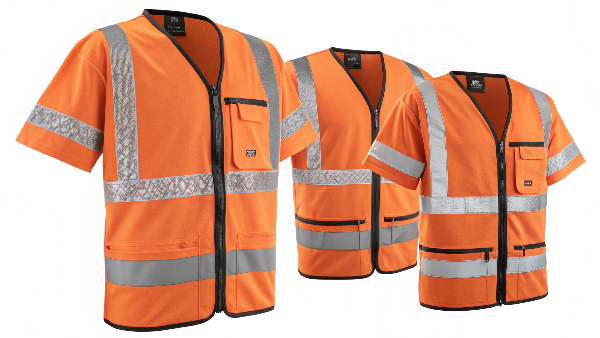
When you see a vest labeled "Class 3 Type R," you are looking at the top tier of high-visibility protection. Let's decode it.
- Type R: As we have covered, this means the garment is performance-rated for roadway environments where workers are exposed to vehicle traffic.
- Class 3: This is the critical part. To meet the Class 3 standard, a garment must have significantly more fluorescent background material and reflective tape than a Class 2 garment. Most importantly, Class 3 garments must have reflective material on the sleeves. This is why you will see Class 3 compliance on jackets, long-sleeve shirts, or vests worn over compliant sleeves, but rarely on a standard vest alone. The sleeves provide a moving biological outline of the human form, which is much easier for a driver's brain to recognize as a person from a distance.
Danny Cheng once had an urgent order for his clients working on a major California highway expansion at night. They absolutely needed Class 3 Type R jackets to meet safety regulations. Our ability to quickly tool up our production lines and meet his tight replenishment deadline is a perfect example of the reliable partnership we build. For us, a label isn't just a label; it's a promise of safety we help our clients keep.
Are safety vest colors like orange, yellow, or even black meaningful?
Does the color of a safety vest really matter? Choosing the wrong one can make workers less visible. Let's explore which colors are compliant and what others mean.
Yes, colors are very meaningful. Fluorescent yellow-green and orange-red are the main ANSI-compliant colors8 for high visibility. They provide the best contrast against most backgrounds. Other colors like black, blue, or pink are used for identification purposes and are not OSHA-approved for visibility.
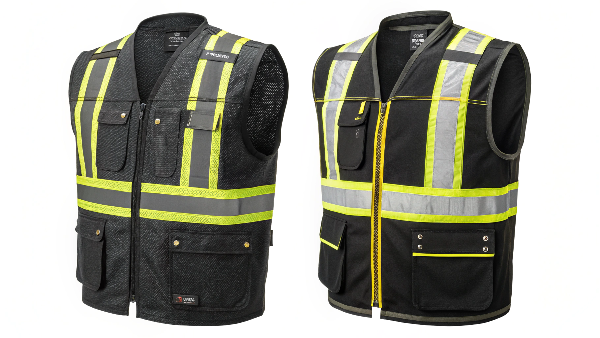
Color choice is not just about style; it is a science based on visibility and contrast. The ANSI standard only approves three colors for high-visibility background material because they are the brightest and most easily seen in a wide range of lighting conditions.
- Fluorescent Yellow-Green9
- Fluorescent Orange-Red
- Fluorescent Red
The best choice between yellow-green and orange-red depends entirely on the work environment. The goal is maximum contrast. For a crew working in a rural, forested area, fluorescent orange-red stands out great against the green and brown background. For a team in a complex urban area with lots of orange traffic cones and equipment, fluorescent yellow-green provides better differentiation.
What about other colors? We often get requests for vests with black, blue, or white panels. These colors are not for visibility compliance10. They are used for identification. For example, a site may use a color-coded system11:
- Black: Often used on the bottom of a vest (a "black-bottom" design) to hide dirt and grime in a high-contact area, extending the usable life of the vest. We produce many of these.
- White/Blue: May signify a supervisor, engineer, or visitor.
- Pink: Sometimes used to identify new workers or for specific event staff.
It is critical to remember that only the fluorescent yellow-green, orange-red, or red portions count toward the total area needed for ANSI compliance.
| Color | ANSI/ISEA 107 Compliant? | Common Use |
|---|---|---|
| Fluorescent Yellow-Green | Yes | All-purpose, great in urban settings |
| Fluorescent Orange-Red | Yes | Great against natural/snowy backdrops |
| Black | No (for visibility) | Hiding dirt on vest bottom, identification |
| Pink, White, Blue, etc. | No | Identification, differentiating roles |
Conclusion
Understanding Type R is crucial for roadway safety. Choosing the right Type, Class, and color ensures your team is protected and your business is compliant.
-
Understanding this standard is crucial for ensuring safety compliance and selecting the right vest for your needs. ↩
-
Learn about the visibility levels of safety vests to choose the right one for your work environment. ↩
-
Class 3 vests provide maximum visibility; knowing when to use them can enhance safety in high-risk areas. ↩
-
Discover the appropriate Garment Types to ensure safety in various work environments. ↩
-
Explore this link to understand the specific features and benefits of Type R vests for roadway workers. ↩
-
Learn about the unique design features of Type P vests that cater to the needs of emergency responders. ↩
-
Find out how user-focused design improves safety vests for different professions, ensuring functionality and safety. ↩
-
Learn about ANSI-compliant colors and their importance in ensuring worker safety and visibility. ↩
-
Discover why Fluorescent Yellow-Green is crucial for safety and visibility in various work environments. ↩
-
Understand the standards of visibility compliance and how they affect safety gear choices. ↩
-
Explore how a color-coded system enhances safety and identification in the workplace. ↩

